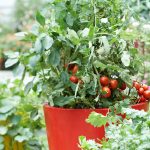To fertilize tomato plants for the best harvest ever, use a water-soluble fertilizer high in phosphorus at planting time. This will promote root growth and enhance flower production, leading to increased fruit yield.
Tomatoes thrive in slightly acidic, rich, and well-drained soil, so ensure the garden bed is prepared with these conditions in mind. Testing the soil for nutrient levels and adjusting the pH as necessary will also help to support healthy plant growth and optimal fruit production.
By providing the necessary nutrients and creating the ideal growing environment, you can maximize the potential of your tomato plants for a bountiful harvest.
Understanding Different Types Of Fertilizers
To ensure the best harvest of tomatoes, it’s crucial to understand the different types of fertilizers and how to use them effectively. By feeding tomato seedlings, applying starter fertilizer at transplant, and side-dressing mature plants, you can boost fruit production and maximize your tomato yield.
Additionally, consider using organic fertilizers rich in phosphorus to encourage flowering and increase fruit size for a bountiful harvest.
Understanding Different Types of FertilizersWhen it comes to fertilizing your tomato plants, it’s crucial to understand the different types of fertilizers available and their impact on plant growth and development. The choice between organic and synthetic fertilizers, as well as the specific nutrient requirements for tomato plants, can significantly influence the health and productivity of your tomato plants.Organic Vs. Synthetic Fertilizers
Organic fertilizers are derived from natural sources such as compost, manure, bone meal, and fish emulsion. They are rich in beneficial microorganisms and provide a slow release of nutrients, promoting long-term soil health. On the other hand, synthetic fertilizers are chemical-based and provide readily available nutrients to plants. While organic fertilizers contribute to improved soil structure and fertility, synthetic fertilizers offer precise control over nutrient composition and are readily absorbed by plants.Nutrient Requirements For Tomato Plants
Tomato plants have specific nutrient requirements to thrive and produce a bountiful harvest. Key nutrients for tomatoes include nitrogen, phosphorus, potassium, calcium, and magnesium. Nitrogen supports foliage growth, phosphorus encourages root development and flowering, while potassium promotes fruit development. Additionally, calcium and magnesium are essential for preventing common tomato disorders like blossom end rot. Understanding and meeting these nutrient needs through proper fertilization will ensure healthy, vigorous tomato plants and a prolific yield.In conclusion, by gaining insight into the different types of fertilizers and the precise nutrient requirements of tomato plants, you can make informed choices to effectively nourish and support your tomato plants for a successful harvest.Ideal Fertilizing Schedule
Proper fertilizing plays a crucial role in ensuring a bountiful tomato harvest. Implementing an ideal fertilizing schedule for your tomato plants can significantly enhance their growth and productivity. To obtain the best harvest ever, it is essential to understand the different stages of growth and the specific fertilizing requirements.
Feeding Seedlings And Transplants
When tomato plants are at the seedling stage or being transplanted, it is crucial to provide them with the appropriate nutrients to establish healthy roots and promote vigorous growth. Utilizing a starter fertilizer enriched with phosphorus can immensely benefit the young plants. This fosters robust root development and sets the stage for strong, productive plants.
Side Dress Fertilizing For Mature Plants
Mature tomato plants greatly benefit from side dress fertilizing. This involves applying nourishing supplements around the base of the plants during their growth stage. Employing organic options such as fish fertilizer can provide an additional nutritional boost, aiding in the development of flavorful and abundant tomatoes. It’s essential to fertilize the plants at regular intervals as they progress through the growing season to ensure sustained nourishment.
Kitchen Scrap Diy Fertilizers
Creating homemade kitchen scrap fertilizers can be a sustainable and cost-effective approach to providing nutrients to tomato plants. Utilizing organic materials like eggshells, banana peels, and coffee grounds can enrich the soil and impart valuable minerals to the plants. These DIY fertilizers not only contribute essential nutrients but also aid in maintaining a healthy soil structure, fostering optimal conditions for robust tomato growth.
Ensuring Even Distribution
When fertilizing tomato plants, ensuring an even distribution of the fertilizer is crucial for optimal growth and abundant harvest. Properly distributing the fertilizer allows all parts of the plant to receive the essential nutrients they need to thrive and produce an abundance of flavorful tomatoes. Here are some effective methods for applying fertilizer and common mistakes to avoid in the process.
Methods For Applying Fertilizer
There are various methods you can use to ensure the even distribution of fertilizer around your tomato plants:
- Top Dressing: Sprinkle the fertilizer evenly around the base of the plants, ensuring it does not come into direct contact with the stems and leaves.
- Side Dressing: Create shallow trenches around the plants and apply the fertilizer into the trenches, then cover it lightly with soil.
- Foliar Feeding: Dilute the fertilizer in water and apply it directly to the leaves using a sprayer, allowing for quick absorption of nutrients.
- Using a Fertilizer Spreader: For larger gardens, consider using a spreader to evenly distribute the fertilizer over the soil around the plants.
Common Mistakes To Avoid In Fertilizer Application
While fertilizing tomato plants, it’s important to avoid certain common mistakes that can hinder even distribution and plant growth:
- Avoid Over-fertilization: Applying excessive fertilizer can lead to nutrient imbalances, burning the roots, and inhibiting healthy growth.
- Uneven Application: Failing to distribute the fertilizer uniformly can result in some parts of the plants receiving too much or too little nutrients.
- Direct Contact with Plant Parts: Directly applying the fertilizer to the stems or leaves can cause burns and damage the plants.
- Timing: Applying fertilizer at the wrong time, such as during extreme heat, can lessen its effectiveness and harm the plants.
A well-distributed fertilizer application can greatly contribute to the health and productivity of your tomato plants, resulting in a bountiful harvest of delicious, home-grown tomatoes.
Fertilizing Tips For Achieving Optimal Yield
Fertilizing tomato plants properly is essential for achieving a bountiful and flavorful harvest. By providing the right nutrients, you can ensure your tomatoes thrive and produce an abundant yield. In this guide, we will cover the importance of balanced nutrient uptake and the top recommended fertilizers for tomatoes, helping you achieve the best harvest ever.
Importance Of Balanced Nutrient Uptake
Tomato plants require a balanced uptake of nutrients to support their growth and fruit development. The three primary nutrients crucial for tomatoes are nitrogen, phosphorus, and potassium. Nitrogen aids in leaf and stem development, phosphorus supports root growth and flower production, while potassium contributes to overall plant health and fruit quality.
Top Recommended Fertilizers For Tomatoes
Choosing the right fertilizer is key to promoting optimal growth and maximizing tomato yields. Here are some of the top recommended fertilizers for tomatoes:
| Fertilizer | Benefits |
|---|---|
| Miracle Gro Tomato Plant Food | Formulated specifically for tomatoes, providing a balanced mix of nutrients for vigorous growth and abundant fruit setting. |
| Dr. Earth Home Grown Tomato | An organic, all-purpose fertilizer designed to enhance soil fertility and promote healthy tomato plants. |
| Neptune’s Harvest Tomato & Vegetable Formula | A fish-based organic fertilizer rich in essential nutrients, promoting strong root development and improved fruit quality. |
| FoxFarm Happy Frog Tomato & Vegetable | Contains beneficial microbes and mycorrhizae to enhance nutrient uptake and improve soil structure for healthier tomatoes. |
| Alaska Fish Emulsion Fertilizer | An excellent source of organic nitrogen and other essential nutrients, promoting robust growth and increased fruit production. |
When using fertilizers, follow the application instructions provided by the manufacturer to avoid over-fertilization, which can lead to nutrient imbalances and adverse effects on plant health. With the right fertilizing approach, you can ensure your tomato plants receive the nutrients they need to thrive and produce an abundant, flavorful harvest.
Identifying Nutrient Deficiencies
To ensure the best tomato harvest, it’s important to identify nutrient deficiencies in the soil and provide the necessary fertilization. Testing the soil for nutrient levels and pH balance can help determine the specific fertilizer needs of tomato plants, promoting healthy growth and higher yields.
It is essential to select appropriate fertilizers that supply the right balance of nutrients to support robust tomato plants and boost fruit production.
Tomato plants can display various signs of nutrient deficiencies. Recognizing these symptoms is crucial for addressing the specific needs of your plants. By observing your tomato plants closely, you can identify the following nutrient deficiencies:– Nitrogen Deficiency: Yellowing leaves, especially at the bottom of the plant, and slowed growth. – Phosphorus Deficiency: Stunted growth, purplish tint on the leaves, and lack of flowering. – Potassium Deficiency: Yellowing or burning of leaf edges, weak stems, and poor fruit development.If you notice any of these signs, addressing the deficiencies promptly can help ensure a bountiful harvest.Addressing Common Fertilization Issues
If you encounter nutrient deficiencies in your tomato plants, it’s important to address them to promote healthy growth and abundant yields. Common fertilization issues can be resolved through the following methods:– Soil Testing: Conduct a soil test to determine the existing nutrient levels and adjust fertilization accordingly. – Balanced Fertilization: Use a balanced fertilizer with equal proportions of nitrogen, phosphorus, and potassium to meet the plants’ nutritional requirements. – Organic Amendments: Incorporate organic matter, such as compost and well-rotted manure, into the soil to improve nutrient levels naturally. Adopting these practices can help rectify nutrient deficiencies and foster optimal growth in tomato plants.Alternative Fertilization Methods For Challenging Environments
In challenging environments where traditional fertilization methods may not suffice, alternative approaches can be employed to ensure the health and vigor of tomato plants. Consider the following alternative fertilization methods:– Foliar Feeding: Administer liquid fertilizers directly to the leaves for rapid nutrient absorption and quick remediation of deficiencies. – Mulching: Apply organic mulches, such as straw or shredded leaves, to retain soil moisture and gradually release nutrients to the plants. – Natural Fertilizers: Utilize natural fertilizers, such as fish emulsion or seaweed extract, to supplement soil nutrients in a sustainable manner.Implementing these alternative fertilization methods can provide effective solutions for challenging environments, leading to thriving tomato plants and an abundant harvest.By identifying nutrient deficiencies and addressing fertilization issues, you can optimize the growth and productivity of your tomato plants. Adopting alternative fertilization methods in challenging environments can further enhance the health and yield of your crops. With the right approach to fertilization, you can ensure robust tomato plants and a bountiful harvest.
:strip_icc()/husky-cherry-tomato-19198666-89f5bcca9a39475a88b6ec3373cee434.jpg)
Credit: www.bhg.com
Frequently Asked Questions On How To Fertilize Tomato Plants For The Best Harvest Ever
What Fertilizer Do Tomatoes Need The Most?
Tomatoes need a fertilizer high in phosphorus at planting time to increase fruit production. Fish emulsion and organic fertilizers are also beneficial.
How Do You Get The Highest Yield On Tomatoes?
To achieve the highest tomato yield, use deep, rich, well-drained soil, and test and adjust the pH. Before planting, ensure the soil is nutrient-rich. Fertilize with a water-soluble, phosphorus-rich fertilizer at planting time for improved harvest.
What Can I Give My Tomato Plant To Produce More Fruit?
To produce more fruit, feed your tomato plants with phosphorous-rich fertilizer for encouraging root growth and flowering. Water them consistently and ensure they have deep, well-drained, and slightly acidic soil. Also, consider using water-soluble fertilizers high in phosphorus at planting time.
What Fertilizer Increases Tomato Fruit Size?
To increase tomato fruit size, use a water-soluble fertilizer high in phosphorus at planting time.
Conclusion
A successful tomato harvest depends on the right fertilization strategy. By understanding the needs of your tomato plants and providing them with balanced nutrients, you can ensure healthy growth and abundant fruit production. Whether using organic or synthetic fertilizers, promoting strong roots and robust flowering will ultimately lead to a bountiful harvest.

I am a graduate of Bangladesh Agricultural University, where I delved into various agricultural disciplines, equipping me with a profound understanding of agriculture. Beyond academics, I have hands-on experience in gardening and crop cultivation. My passion is to embrace sustainable farming and horticulture. With a BSc in Agriculture, I am dedicated to promoting environmentally conscious and efficient agrarian practices.
Bachelor of Science (BSc) in Agriculture (Hons.)
Master of Science. (Sustainable Agriculture & Food Security ) (MS)
Bangladesh Agricultural University




